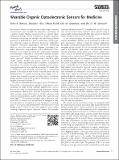Wearable organic optoelectronic sensors for medicine
Abstract
Organic optoelectronic devices that can be used to make compact, wearable sensors for medicine and sports are shown and two examples are given: a tissue-oxygenation sensor and a muscle-contraction sensor. It is demonstrated how the muscle-contraction sensor on a volunteer's arm can successfully control the robot arm.
Citation
Bansal , A K , Hou , S , Kulyk , O , Bowman , E M & Samuel , I D W 2015 , ' Wearable organic optoelectronic sensors for medicine ' , Advanced Materials , vol. 27 , no. 46 , pp. 7638–7644 . https://doi.org/10.1002/adma.201403560
Publication
Advanced Materials
Status
Peer reviewed
ISSN
0935-9648Type
Journal article
Description
This work was supported by Engineering and Physical Sciences Research Council Programme Grant “Challenging the limits of photonics: Structured light” (grant number EP/J01771X/1) and MRC.Collections
Items in the St Andrews Research Repository are protected by copyright, with all rights reserved, unless otherwise indicated.

